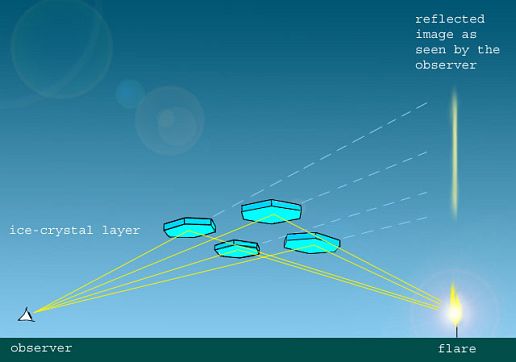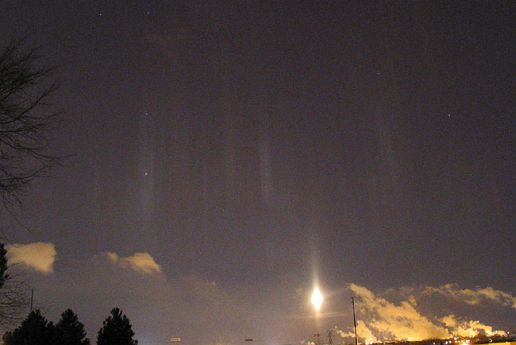|
R e s e a r c h
Mechanism
When the air temperature sinks below 0° C and the moisture content of the air is sufficiently high, microscopic particles in the atmosphere (most of which are produced by automobiles, industrial sites, forest fires, volcanoes and ocean spray) act as nuclei for the formation of ice crystals. Such crystals can take a wide variety of shapes. Stars, needles, columns and hexagonal plates are most commonly encountered [4]. Because hexagonal-plate crystals and ice columns have the largest surfaces of all crystal types, they will reflect more light than stars and needles. The formation of hexagonal ice-crystal plates is favoured at air temperatures from 0° C to -4° C and from -10° C to -20° C and below. When their size is less than 15-20 micrometers across, they tumble randomly through the air. But when the plates are larger, ranging roughly from 0.1 to 1 mm, they fall so that their long dimension parallels the ground, i.e. with their larger axis horizontally. Falling plate crystals also tend to wobble or oscillate about this orientation. Ice columns, which form in the temperature ranges from -5° C to -8° C and below -25° C, resemble hexagonal plates that are long in comparison to their cross section. They also fall with their long side paralleling the ground. Because of this, both crystal types provide excellent horizontal surfaces that act like small mirrors. Light rays coming from a ground-based source will hit the crystal's upper and lower surfaces and reflect back to the ground at an angle that matches the incident angle [5]. 
Symmetrical, hexagonal ice-crystal plates, like the ones pictured above left, form in a moist atmosphere at temperatures of around -10° C. When falling, such flattened ice crystals will align themselves to the ground, much like a sheet of paper that is dropped from a sufficient height. The third crystal in the row is a hollow column. The one to the far right is a composite column and plate crystal.
Many ice crystals together form a cloud, the shape and thickness of which is defined by air currents and the temperature of the surrounding air. An ideal situation for pillar-shaped reflections to occur at high altitudes is when a slow, upward motion of warm air prevents the crystal plates from falling and forces them to divert laterally, grouping millions of ice-crystal plates in a flat horizontal layer. When such a stable zone of floating ice crystals develops, it will take the aspect of a huge horizontal plate of glass in which powerful ground-based lights will reflect. In our search for reports pillar-shaped lights we uncovered very few observations from mountainous regions. A possible explanation for this is that stable, horizontal cloud layers form more easily over a flat terrain. 
Simplified diagram showing the reflection of a flare on the flat surfaces of horizontally oriented ice-crystal plates. [© CAELESTIA]
Ice-crystal clouds can be so thin that they are barely visible to the naked eye. On various occasions, pillar-shaped reflections have been photographed together with stars piercing through transparent cloud layers or through holes in the cloud cover. Such pictures make it possible to determine the elevation of the photographed reflection. When also the distance between the light source and the camera is known, it is easy to calculate the actual height of the reflecting cloud base. We explain how this is done in the next chapter.
Table I: Altitude of the reflecting cloud layer (h) for 25 confirmed cases, as derived from the distance between the observer and the light source (D) and the elevation of the reflected image (α), using the formula: h = (D/2) x tan α. Elevations were mostly obtained by comparing the position of the reflection to that of neighbouring stars (several cases in this list have photographs which can be found in the picture gallery). Distances were measured on maps, except for the Belgian cases for which a computerised position-finding program was used (this program can be found at www.gisvlaanderen.be). Values between brackets are rough estimates. The height of the standpipes (usually between 150 and 220 m) is not factored into the calculations.
Sighting reports have been collected for any time of the year. Contrary to our expectations, we recorded no increase in sightings during winter months.

The brightest light in this overexposed wide-angle shot is the Moon. Ice crystals in transparent cloud layers are responsible for the vertical beam of light that extends above and below the moon disk. In the upper part of the photo, a series of weak pillar-shaped reflections can be seen. These are caused by spotlights on the ground reflecting off the same ice-crystal cloud. This rare combination of a moon pillar and artificial light pillars was photographed on January 5, 2004, by Mrs. Peg ZENKO of Green Bay, Wisconsin. Extra caution should be observed when interpreting statistical data relative to this type of reports. It is obvious that the collection of cases depends largely on the "reporting chance", i.e. the whole set of factors that influences the chance of someone seeing and reporting the mirrored image of a ground-based light in the night sky. Some of these influencing factors are: less people outside on colder nights; early sunsets in winter months; population density; more light pollution in cities and imposed flaring restrictions when temperatures are below zero. On top of this, there is the readiness of astronomical and meteorological societies to register light pillar reports. This too will have an influence on the number of cases collected from region to region.
Designation
Much thought was given as to how to designate the phenomenon. One observer who photographed a series of reflections during a visit to the George Observatory in Houston, Texas, referred to the lights as "flare dogs" by analogy with sun and moon dogs. Because the mechanism responsible for the lights is almost identical to the mechanism that causes halo phenomena, and in particular sun pillars and moon pillars, it would indeed seem appropriate to rank the phenomenon as a special type of halo phenomenon. In this line of thought, "flare pillars" would have been a better designation than "flare dogs" because sun and moon dogs almost never have the shape of a pillar and always appear to the left and/or right of the Sun or the Moon. But then again, not all reflections are caused by flares.
Notes & References
[4] For more info on ice-crystal formation and the properties of ice crystals, see: |
||||||||||||||||||||||||||||||||||||||||||||||||||||||||||||||||||||||||||||||||||||||||||||||||||||||||||||||||||||||||||||||||||||||||||||||||||||||||||||||